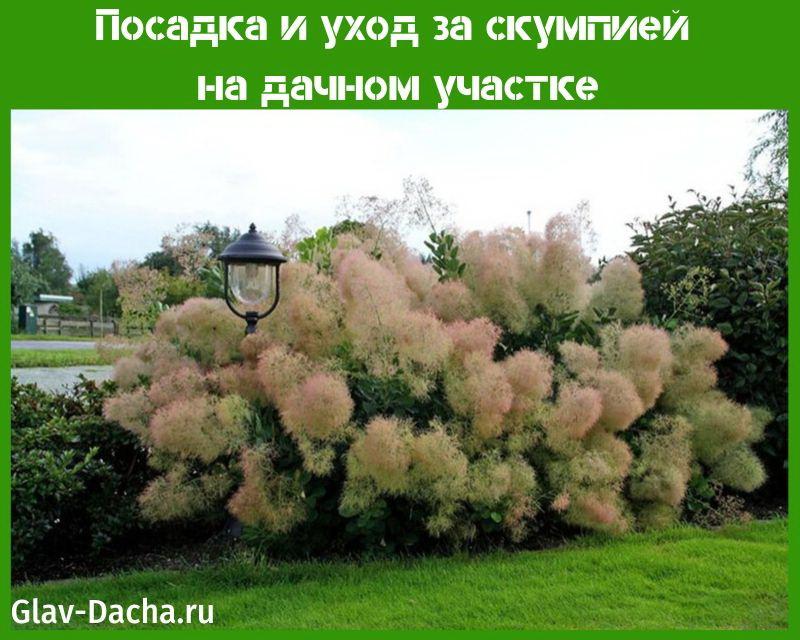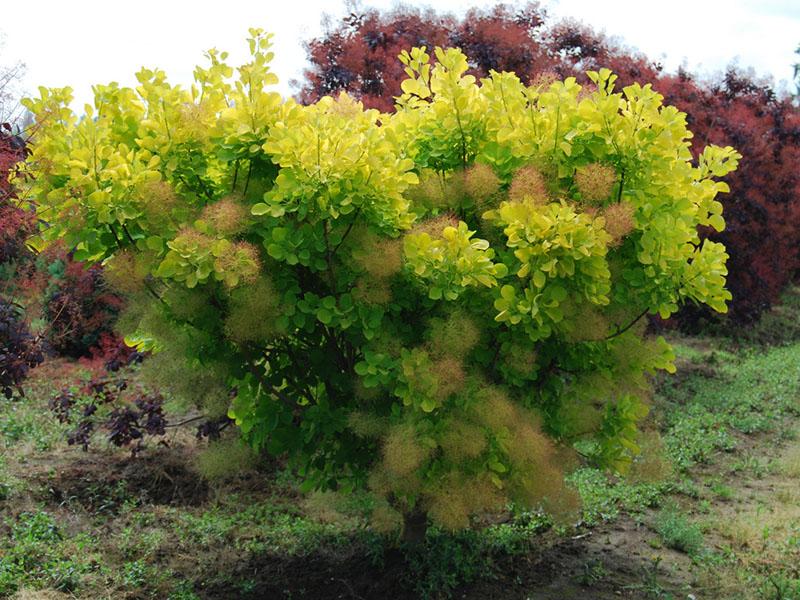Planting and caring for the skumpia at their summer cottage
 It is not often at the summer cottage that you can see an unusual scumpia, although the plant looks very attractive during flowering. We recommend that lovers of ornamental plants pay attention to the tree and use it in landscape design. After all, planting and caring for a scumpia is not difficult, and the plant will thank you with lush bouquets.
It is not often at the summer cottage that you can see an unusual scumpia, although the plant looks very attractive during flowering. We recommend that lovers of ornamental plants pay attention to the tree and use it in landscape design. After all, planting and caring for a scumpia is not difficult, and the plant will thank you with lush bouquets.
Why is the scumpia attractive?

 Unusual Scumpia vulgaris belongs to the Anakardia family and is distributed practically throughout the Eurasian continent, with the exception of Western and Central Europe. Under favorable conditions of existence, it can live for more than 100 years and reach a height of 5 m. The tree has a crown in the shape of a ball or umbrella. The thin bark is red-brown, thin shoots turn red over time. The root system of this plant is extremely ramified, which is important to consider when placing in the garden and choosing companions. Leaves are oval, almost round, usually 8-10 cm long and about 7 cm wide. They emerge from the buds in mid-April and at the end of autumn, turning in a rich red or purple color, they fall off. Flowers, similar to panicles, can be from 15 to 30 cm. After flowering, green bone fruits are formed, which, as they mature, acquire thin veins and turn dark brown.
Unusual Scumpia vulgaris belongs to the Anakardia family and is distributed practically throughout the Eurasian continent, with the exception of Western and Central Europe. Under favorable conditions of existence, it can live for more than 100 years and reach a height of 5 m. The tree has a crown in the shape of a ball or umbrella. The thin bark is red-brown, thin shoots turn red over time. The root system of this plant is extremely ramified, which is important to consider when placing in the garden and choosing companions. Leaves are oval, almost round, usually 8-10 cm long and about 7 cm wide. They emerge from the buds in mid-April and at the end of autumn, turning in a rich red or purple color, they fall off. Flowers, similar to panicles, can be from 15 to 30 cm. After flowering, green bone fruits are formed, which, as they mature, acquire thin veins and turn dark brown.
Planting and caring for the skumpia
 The choice of planting material should be done only in reliable nurseries or specialized agricultural firms. If the plant has damaged buds or damaged bark, then, most likely, the shrub will not take root. In addition, you should pay attention to the condition of the roots. They should not show signs of decay or breakage. If the plant is purchased without an earthen coma, then it should be planted once.
The choice of planting material should be done only in reliable nurseries or specialized agricultural firms. If the plant has damaged buds or damaged bark, then, most likely, the shrub will not take root. In addition, you should pay attention to the condition of the roots. They should not show signs of decay or breakage. If the plant is purchased without an earthen coma, then it should be planted once.
Planting dates and soil selection
 Scumpia is usually planted either in mid-spring or mid-autumn. Skumpia is a shrub that prefers well-consecrated areas. If you plant it in the shade, the plant will quickly lose its decorative effect - the leaves will fade, and the paniculate flowers will become scanty and unsightly.
Scumpia is usually planted either in mid-spring or mid-autumn. Skumpia is a shrub that prefers well-consecrated areas. If you plant it in the shade, the plant will quickly lose its decorative effect - the leaves will fade, and the paniculate flowers will become scanty and unsightly.
An ornamental shrub prefers light, breathable, neutral or alkaline nutrient soils. However, on rocky soils, it is also able to grow well, but the development of the plant will not be intense.
The process of planting the scump in the ground
 To plant the scumpia in the ground, you should dig a hole slightly smaller than the root system of the plant. Before deepening the seedling into the ground, you should take care of drainage by laying expanded clay, shards or medium-sized pebbles at the bottom. In addition, the hole must be well shed before planting.
To plant the scumpia in the ground, you should dig a hole slightly smaller than the root system of the plant. Before deepening the seedling into the ground, you should take care of drainage by laying expanded clay, shards or medium-sized pebbles at the bottom. In addition, the hole must be well shed before planting.
When the scumpia is in the place allotted to it, care should be taken that the roots are spread out in a ray-like manner.
Only after that can you sprinkle the plant with earth, making sure that the root collar rises 5-7 cm above the ground.
Watering, pruning and preparing for winter
 Scumpia does not like waterlogged soil. Therefore, watering should be carried out when the topsoil dries out a little. If there are prolonged rains, watering should be stopped altogether.
Scumpia does not like waterlogged soil. Therefore, watering should be carried out when the topsoil dries out a little. If there are prolonged rains, watering should be stopped altogether.
The earth circle around the plant should be kept clean and weeded regularly. In order for the moisture to be preserved in a natural way, sprinkle the trunk circle mulch from pine bark.
 Successful planting and caring for the scumpia is simply impossible without timely pruning of the plant. Scumpia pruning is carried out regularly, every 2 years. The best time for this procedure is early spring, before the first foliage appears on the tree.
Successful planting and caring for the scumpia is simply impossible without timely pruning of the plant. Scumpia pruning is carried out regularly, every 2 years. The best time for this procedure is early spring, before the first foliage appears on the tree.
Timely pruning stimulates the growth of side shoots, forms a crown and has a rejuvenating character.
 Scumpia is a thermophilic plant. Prolonged frosts without providing reliable shelter are destructive for her. To protect the skumpia from freezing, you need to cover the trunk circle with a thick layer of mulch, and cover it with spruce branches or non-woven material on top.
Scumpia is a thermophilic plant. Prolonged frosts without providing reliable shelter are destructive for her. To protect the skumpia from freezing, you need to cover the trunk circle with a thick layer of mulch, and cover it with spruce branches or non-woven material on top.
Reproduction of scumpia
Scumpia propagation is carried out in 4 ways:
- seeds;
- cuttings;
- layering;
- jigging young shoots.
Reproduction by layering
 The easiest way to get fresh planting material is to cut from the mother plant.
The easiest way to get fresh planting material is to cut from the mother plant.
This requires:
- Choose a sturdy shoot close to the ground.
- On the stem, in the place that you plan to drop in, make a neat incision to speed up root formation.
- Next, bend the stem, secure with a garden paper clip and sprinkle with earth.
- The final stage is a plentiful shedding of the plant.
Once the plant has established roots, carefully separate the seedling from the mother shrub and transplant to a permanent location.
Propagation by cuttings
 This is not to say that propagating scumpia by cuttings is not an easy task. The optimal time for breeding in this way is the end of June. The main component of success is the preparation of planting material. For cuttings, a healthy adult plant is selected, from which shoots at least 20 cm long with 4-6 buds are separated.
This is not to say that propagating scumpia by cuttings is not an easy task. The optimal time for breeding in this way is the end of June. The main component of success is the preparation of planting material. For cuttings, a healthy adult plant is selected, from which shoots at least 20 cm long with 4-6 buds are separated.  The lower leaves are removed and the cuttings are placed in a phytohormone solution for several hours to stimulate root formation. A soil mixture made from sand is poured into the seedling box, peat and turf. Next, the cuttings are planted. After the young plants are planted, it is necessary to create greenhouse conditions for them, covering them with a plastic cap.
The lower leaves are removed and the cuttings are placed in a phytohormone solution for several hours to stimulate root formation. A soil mixture made from sand is poured into the seedling box, peat and turf. Next, the cuttings are planted. After the young plants are planted, it is necessary to create greenhouse conditions for them, covering them with a plastic cap.
Care of young growth is reduced to timely watering or irrigation and regular ventilation.
Acquaintance with the varieties of scumpia for the Moscow region
Planting and caring for a skumpia in the Moscow region requires special attention and effort from the gardener. Choosing the right scumpia variety for your region will help you grow a truly beautiful plant.
Scumpia royal purple (Royal purple)
 Unlike other representatives of this species, the royal purple scumpia can be quite impressive in size, growing up to 4 m. The reversible shape and the purple-red royal color of the foliage makes this plant extremely decorative. By autumn, the leaves take on a bluish tint.
Unlike other representatives of this species, the royal purple scumpia can be quite impressive in size, growing up to 4 m. The reversible shape and the purple-red royal color of the foliage makes this plant extremely decorative. By autumn, the leaves take on a bluish tint.
Skumpia tannery Royal pearl blooms with paniculate flowers of pink color. When fruits are formed, the pedicels elongate, becoming covered with hairs. At this time, the plant looks very impressive. In landscape design, it is most attractive as an independent plant, without companions. Prefers open, well-consecrated places.
Scumpia Grace
 Hybrid scumpia Grace, obtained from crossing the varieties Velvet Cloak and Cotinus obovatus, is distinguished by strong branching, a well-developed spherical crown, and long flowering. The leaves are emerald in color with a bluish tint, which turn purple as autumn approaches.
Hybrid scumpia Grace, obtained from crossing the varieties Velvet Cloak and Cotinus obovatus, is distinguished by strong branching, a well-developed spherical crown, and long flowering. The leaves are emerald in color with a bluish tint, which turn purple as autumn approaches.
The flowering period is from May to August. The flowers are paniculate, milky or greenish in color, which, during the period of fruit ripening, are covered with red or pink hairs. During this period, Grace is especially beautiful. Prefers open sunny areas, but will feel good in partial shade. It does not tolerate snowless frosty winters, so you need to take care of a reliable shelter and protection from drafts and a sharp drop in temperature in time.
Skumpia leather ordinary, as well as various varieties of this plant, are increasingly appearing in dachas near Moscow and in gardens. Unfortunately, the unpredictability of the climate is increasingly upsetting gardeners with the fact that it is becoming more and more difficult to provide a handsome plant with 100% care in summer and protection in winter. Therefore, you should be more careful about choosing a planting site, organizing drainage and protecting the plant from winter bad weather.